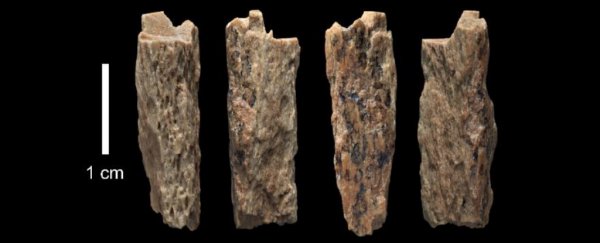A 13-year-old girl who died over 50,000 years ago may not have had a long time alive on this planet, but she was in fact very special. Millennia later, a fragment of her skeleton reveals that she was the first-generation result of a mating between two different species of hominin.
Her mum was a Neanderthal, and her dad was a Denisovan, genome sequencing has revealed. So this tiny sliver of her remains represents direct evidence that the two species were interbreeding.
"We knew from previous studies that Neanderthals and Denisovans must have occasionally had children together," said evolutionary geneticist Viviane Slon of Max Planck Institute for Evolutionary Anthropology in Germany.
"But I never thought we would be so lucky as to find an actual offspring of the two groups."
The existence of the Denisovans wasn't uncovered until 2010, but since then we've learned more and more about them.
Neanderthals and Denisovans were probably the same group originally. But, sometime over 390,000 years ago, they separated, and evolved into two distinct, but closely related populations.
They coexisted in Eurasia for a long time. Although Denisovans are only known from bones found in one location - the Denisova Cave in Siberia (actually named after a bloke named Denis) - Neanderthal remains were also found there.
But it didn't mean they hung out there at the same time. So the discovery of this adolescent girl, named Denisova 11 (or Denny, as nicknamed by the researchers), is an astonishingly solid confirmation that the two groups knew each other, and interacted.
Denny is known only from a small fragment of bone, found in the cave in 2012 by Russian archaeologists. Based on a protein analysis, it was confirmed to be a hominin bone, so it was transferred to the Max Planck Institute for further study.
There, researchers analysed the bone and determined that it was likely part of a tibia, femur or humerus. Based on that assumption, the bone's cortical thickness indicates that Denny was at least 13 years old when she died, while radiocarbon dating put the time of her death over 50,000 years ago.
Next, they took DNA samples from the bone, and sequenced Denny's genome. They discovered her sex - and her unusual parentage. A Neanderthal mother and Denisovan father.
"An interesting aspect of this genome is that it allows us to learn things about two populations - the Neanderthals from the mother's side, and the Denisovans from the father's side," said geneticist Fabrizio Mafessoni of the Max Planck Institute for Evolutionary Anthropology.
Denny's DNA revealed that her mother was genetically closer to a population of Neanderthals who had lived in Western Europe than those who had lived in Denisova Cave in the East some 20,000 years earlier.
This indicates that the Neanderthals were migrating across Europe tens of thousands of years before they disappeared.
But Denny's mum wasn't the only one with a story to tell. Dad's DNA was interesting too. Based on what the researchers could glean from Denny's bone, he'd had at least one Neanderthal ancestor.
"So from this single genome, we are able to detect multiple instances of interactions between Neanderthals and Denisovans," said geneticist Benjamin Vernot of the Max Planck Institute for Evolutionary Anthropology.
What's interesting is that the two groups remained genetically distinct, rather than intermingling to form one species that incorporated both. This, the researchers noted in their paper, could mean that their zones of overlap were limited, both temporally and geographically.
But one more thing is really interesting. So far, only four other Denisovans have been identified via DNA analysis. Denny is the fifth.
"It is striking that we find this Neanderthal/Denisovan child among the handful of ancient individuals whose genomes have been sequenced," said evolutionary geneticist Svante Pääbo, Director of the Department of Evolutionary Genetics at the Max Planck Institute for Evolutionary Anthropology and senior author of the study.
"Neanderthals and Denisovans may not have had many opportunities to meet. But when they did, they must have mated frequently - much more so than we previously thought."
Isn't it amazing what we can learn from a single piece of ancient bone?
The team's research has been published in the journal Nature.
